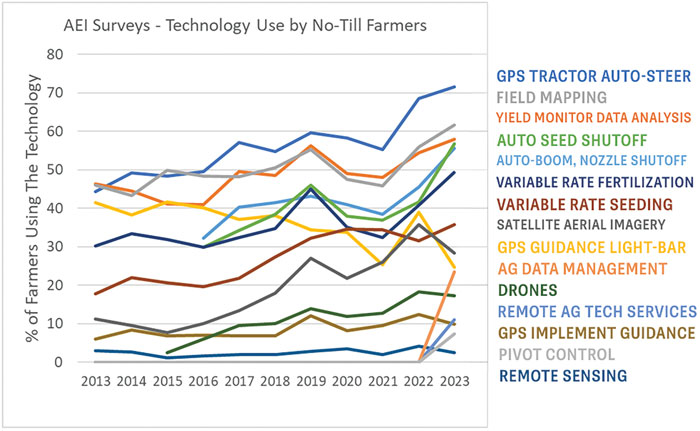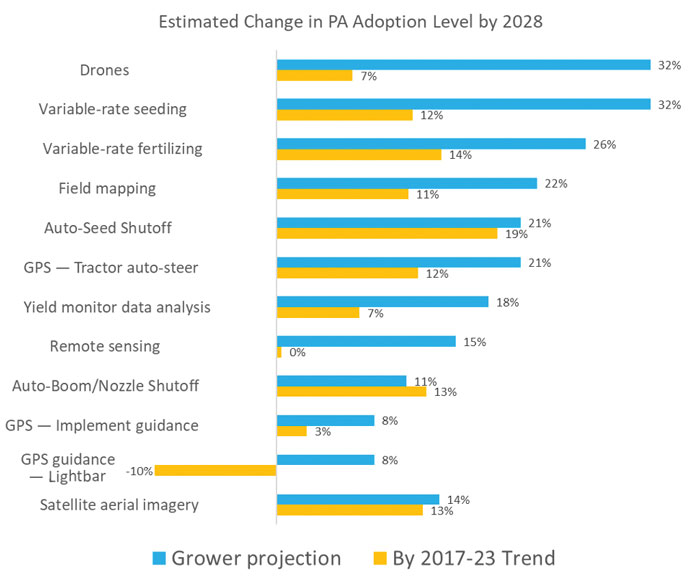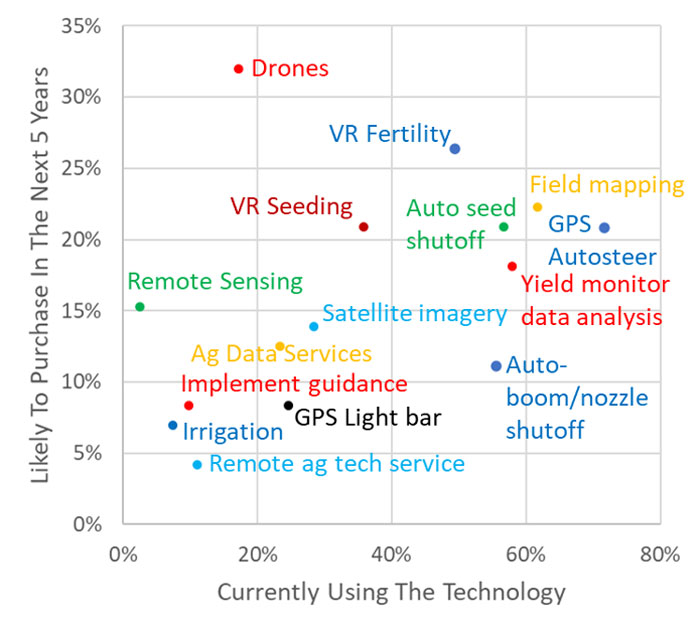No-tillers tend to be early adopters of technology because they’re very comfortable with retrofits. In a high-residue environment, one-size-fits-all equipment won’t cut it.
No-Till Farmer has been conducting regular surveys about precision usage since 2013. The graph below shows trends for 15 precision ag technologies, showing a consistent upward trend, aside from a temporary downturn in 2020 and 2021.
In a 2023 Ag Equipment Intelligence survey, no-tillers projected what technology they expected to purchase within the next 5 years. Even for widely used options like variable-rate fertilizer, GPS auto-steer, auto seed shutoff and yield monitoring data analysis, more than 15% of no-tillers indicated they would likely purchase the technology in the next 5 years. Among technologies with less than 40% current adoption, drones, VR seeding and remote sensing were given at least a 15% purchase projection in that same time period.
The survey data and related commentary was collected into the “Precision Ag Adoption Among No-Tillers” report. Here are three takeaways from the report regarding how no-tillers could benefit from using more precision ag technology:
1. Improved Economics
Guidance technologies facilitate an optimally efficient path through the field that eliminates overlaps and achieves full coverage. This results in immediate fuel savings, reduced wear and tear on equipment, reduced losses associated with “misses” of fertilizer or pest control products, and reduced cost through avoidance of duplication during fertilization or spraying. If equipment operators are hired staff, there can also be salary savings.

With the exception of a brief downturn in 2020-21, no-tillers’ adoption of various precision technologies has been largely consistent over the last 10 years.
Guidance, particularly auto-steer, is becoming standard practice in row-crop agriculture in the U.S. No-tillers’ adoption of auto-steer is projected to reach 80-90% by 2028, according to Ag Equipment Intelligence. Purchasing plans provided by the surveyed no-tillers suggest as much as a 21% increase in adoption by 2028, which would exceed the 12% rise based on the 2017-23 average rate of increase.
Variable rate (VR) seeding, fertilizer and chemical applications can reduce cost through reduced rates in some parts of a field, but the best economic outcome occurs when those technologies unlock greater yield potential by focusing more inputs on the most potentially productive zones.
Depending on the details of the farming operation, the greatest economic advantages may occur with certain combinations of technologies, often referred to as tech stacks, according to a 2016 USDA economic research report. Precision agriculture can also play a role in qualification for additional sources of income, including government programs and private market incentives.
“Precision agriculture fits well with the overall reduced input focus of regenerative ag, particularly when it comes to phosphorus applications,” says Mitchell Hora, a Washington, Iowa, no-tiller and founder of Continuum Ag.
2. Agronomic Benefits
Other uses for drones involve addressing non-uniform pest infestations, delivering micronutrients and applying nitrogen in environmentally sensitive locations. Operators can fly drones over the field to identify weed species at a 1½-centimeter resolution, and that information can be used to develop a detailed spraying prescription for either ground or aerial/drone application. Drone-based mapping could also be used to refine nutrient supplementation or detect uneven distributions of insect and disease pressure.
In general, precision technology can make split fertilizer applications more feasible and accurate. More than 60% of no-tillers used VR fertilization in 2023. The no-tillers interviewed in 2023 projected a 26% increase by 2028, which would mean 90% adoption. The trendline over the past 6 years suggests a 14% increase by 2028. The VR fertilization rates in the USDA single crop studies are lower than the No-Till Farmer survey results, placing adoption at less than 30% in 2019.
There are companies that offer spray equipment designed to variably apply crop protection products during planting. The technology targets pests like the soybean cyst nematode, detected and mapped from soil samples with DNA sequencing techniques, or weeds detected either with on-the-move sensors or earlier drone mapping.
Post-planting crop protection for the sprayer is a popular precision technology. Smart sprayers use artificial intelligence, cameras and other sensors on spray booms as section controllers or nozzle shutoff. This reduces herbicide or other product usage, prevents coverage overlaps and eliminates sprays outside of the target zone, particularly at field margins.
No-tillers reported around 40% use from 2017-21. By 2023, there had been another 15% increase in adoption with another 11% anticipated by 2028. This trend is very similar to that estimated for growers as a whole, just delayed several years. Many growers have an interest in optimally efficient herbicide and pesticide use because of current and future pressures to reduce overall chemical use. Surveyed no-tillers projected buying an additional 11% of autoboom/nozzle shutoff tools by 2028, close to the rate of annual gain in recent years. The 6-year trendline estimate is somewhat higher at 13%.
3. More Detailed Crop Monitoring
Soil mapping is a key enabling factor for multiple precision agriculture practices. Soil nutrient status is used to inform variable fertilization, but other soil properties can be used to drive planting and pest management prescriptions.
Soil mapping may be increasing to as much as 40% in the near future, and dealers estimate that there is growth in adoption of that technology by growers. The details of soil mapping adoption were not captured in the no-till-specific survey. It is likely that soil sampling is part of the 22% increase in adoption that no-tillers project by 2028.
There are two developments that are likely to make soil sampling a more refined process in the future. One is the use of autonomous vehicles to gather soil samples. The other is generating more complex data from soil samples. The overall biological activity of a soil can be characterized by something like the Haney test. Rapid advances in genetic sequencing technology make it possible to characterize the composition of the soil microbiome. In the future, farmers and agronomists could write prescriptions based on the amount of phosphate-cycling organisms, or presence of soybean nematodes or certain fungal pathogens.
The overall farmer and no-tiller use of satellite imagery has grown from the low teens in 2013 to nearly 30% in 2023. Another 14% of no-tillers project purchasing that technology by 2028, and the 6-year trendline suggests at least 12% more no-tillers will start to use satellite imagery.

No-tillers anticipate the largest growth in precision technology use to be drones and variable-rate seeding, according to a 2023 survey.
Dealers are already offering unmanned aerial vehicle (UAV) or drone imaging services, and that may soon be the case for more than 60% of dealers. No-tillers project a 32% increase in drone purchases by 2028, but the survey results didn’t specify how the farmers will use the drones, whether for aerial imagery, spraying, fertilizing or cover crop seeding.
Grower adoption of chlorophyll/green sensors to detect nutrient deficiencies has been slow, and many of the no-tillers interviewed these sensors aren’t timely enough. But with the relatively high price of fertilizer and concerns about future regulatory limits, 18% of no-tillers expected remote sensing in general to be technology they will begin using by 2028 — an increase of 15%.

When it comes to precision ag technologies that no-tillers are already using — such as variable rate fertilization and GPS autosteer — more than 15% of respondents said they were likely to purchase the technology in the next 5 years.





